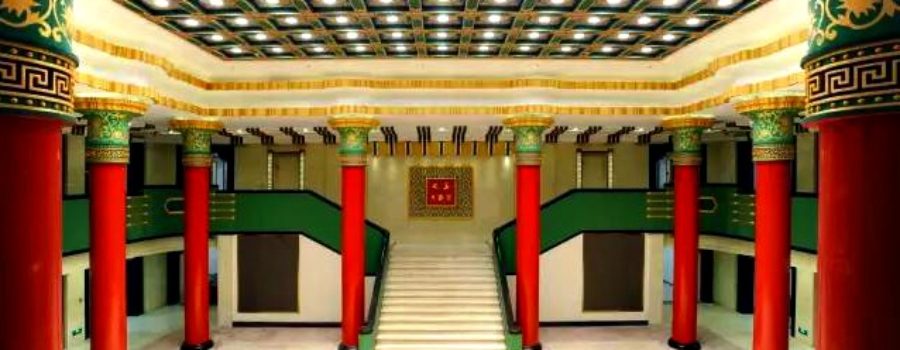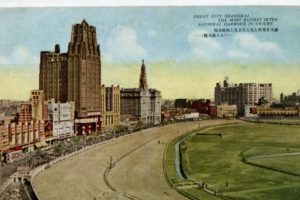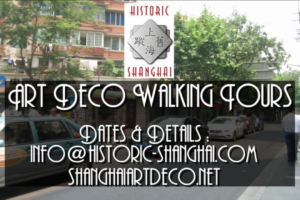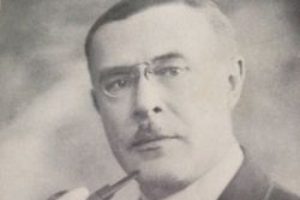Nanjing is the home of Chinese Art Deco, that alchemy of east and west born of a modernizing China. Nanjing became the capital of the Republic of China in 1927 under Chiang Kai-shek’s Nationalist government, and “Nanjing Decade” that followed celebrated this style in way that had not been done before — or since. Nationalist Nanjing was a planned city, and the 1929 Plan of the Capital not only included architectural style as one of the components of planning, it also decreed that since the Chinese style was “the most beautiful in color and arrangement …. and broadcasts the culture of the country”, it should therefore be used for government and commercial buildings. We’ve gathered some of our favorites below – if you’d like to see them in person, join us on our upcoming weekend in Nanjing. Nanjing Decade: Art Deco in the Southern Capital June 25-27 2021, for details, click here.
- Da Hua Cinema (Yang Tingbao, 1934)
The Da Hua Cinema’s exterior is a western Art Deco gem – all clean lines and racing speedlines – inside, University of Pennsylvania graduate Yang Tingbao has countered that with a riot of Chinese Art Deco – red pillars, a dramatic sweeping staircases, and intricate decoration, an Art Deco yin-yang.
- Linggu Pagoda (Henry K. Murphy, 1932)
American architect Henry K. Murphy was an early pioneer of the adaptive Chinese Renaissance style, combining western construction with classical Chinese architectural style. His nine-storey, 60 meter-high Linggu pagoda, a memorial to soldiers who had lost their lives during the Northern Expedition, used the innovation of reinforced concrete and a modernist staircase.
- Nanking Central Stadium (Kwan, Chu & Yang, 1931)
The Central Stadium and sports complex was built on the grounds of the Sun Yat-sen Mausoleum for a national sports event in 1931 that never took place. The structure of Yang Tingbao’s stately stadium owes more in inspiration to buildings like the Los Angeles Coliseum than any traditionally Chinese structure, but even though these were “entirely new building types that had no precedent in Chinese architecture,” [Edward Denison, Modernism in China] Yang’s Chinese motifs and finials make it a distinctively, decidedly Chinese. The stadium seats 600,000 spectators, and also on the grounds are the intact lawn tennis courts and indoor swimming pool.
- Mei Ling Palace (1934)
Mei Ling Palace was an extravagant birthday gift from Nationalist leader Chiang Kai-Shek to his wife, the glamorous Soong Mei Ling, a Purple Mountain hideaway designed in the Chinese Art Deco style he had insisted upon for the rest of his capital. The mansion features a streamlined Art Deco building with Chinese architectural accents on the exterior, while the Art Deco interior is much more western. Now a museum.
- International Club (Liang Yen of Kwan, Chu & Yang, 1936)
Nanjing’s International Club is a beautifully proportioned Art Deco building, whose shapes tell the story rather than the minimal decoration. Despite an exterior so western that it would be at home in New York or Miami, the interior originally featured Chinese accents (today that’s all gone, replaced by an anonymous modern interior). The building was designed by Kwan Chu and Yang’s talented Liang Yen, who was Frank Lloyd Wright’s first trainee (1932).
- Sun Ke Villa (Yang Tingbao, 1948)
The talented Yang Tingbao of Kwan, Chu & Yang designed this unapologetically Modern private residence for Nationalist leader Sun Ke, Sun Yat-sen’s only son in 1948. Set in large verdant grounds, the building is a bevy of angles on the exterior, while the interior features walls almost entirely of glass casement and a spiral staircase.














Most Commented Posts